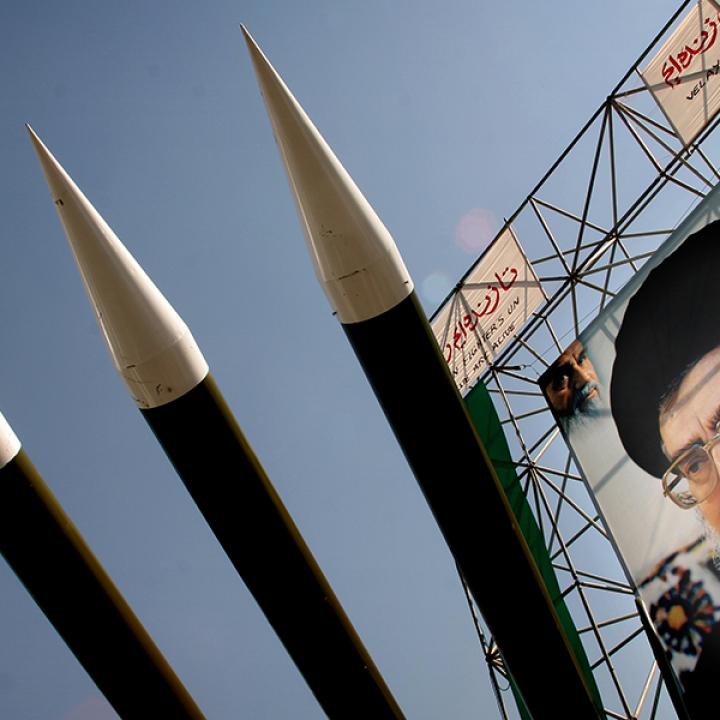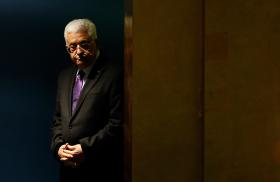
- Policy Analysis
- PolicyWatch 2795
Iran's Presidential Election: Balancing Diplomacy and Confrontation

Washington's working relations with the next president should not preclude it from leading the fight against the IRGC's missile proliferation and regional militancy.
This PolicyWatch is the first installment in a three-part series on Iran's upcoming election. Read part two (on economic issues) and part three (on the clergy's role).
Iran is a country at war, in Syria, Iraq, and Yemen. Yet the candidates campaigning for the May 19 presidential election have hardly spoken a word about the country's regional and military policies. Their silence speaks volumes about Iran's political system. Whoever is elected president will have no authority over the military or the malign activities of Iranian-led Shiite militias. So should the election matter to the United States? And how should Washington approach the winner of this month's vote?
THE PRESIDENCY AND IRAN'S POLITICAL SYSTEM
A complex political system has evolved in Iran since the Islamic Revolution nearly four decades ago. An elected government, including the president and parliament, is tasked with day-to-day management of the country, while the Supreme Leader and appointed institutions such as the Islamic Revolutionary Guard Corps act as the "guardians of the revolution," setting policies for Iran's involvement abroad and most everything else. The president has no authority over the two main pillars of Iran's regional strategy: the IRGC's ballistic missile program and its legion of Shiite militias operating throughout the Middle East. The destabilizing activities carried out by the IRGC and its proxies directly affect the security and interests of the United States and its allies, and the election (or reelection) of a moderate president will not reduce that threat level.
Yet the election still matters up to a point. Iran is a major regional actor, so the United States and other countries need to maintain relations with it. The elected government generally represents the Islamic Republic in regional and international talks, and the president is the face of the government. For example, the negotiations leading up to the 2015 nuclear deal showed the president's importance in navigating sensitive international issues. To be sure, the talks would not have begun, nor would the deal have been reached, without the Supreme Leader's explicit approval. Yet President Hassan Rouhani's team believed in the process, showed good intentions, and played a critical role in facilitating the discussions preceding the agreement. A different president might have been less enthusiastic in striking a deal with the West and could have raised issues that blocked or delayed it.
The election also matters on the economic front, a key component of Iran's stability. The president and his government play an important role in the country's monetary policies and, to some extent, fiscal policies. For example, Rouhani's government inherited an economy that was trending toward hyperinflation near the end of his predecessor's term.
But here too, the power of the presidency is seriously constrained by revolutionary institutions. Nearly half of Iran's economic activities are managed by a dozen mega-foundations controlled by either the Office of the Supreme Leader or the IRGC. This so-called "nongovernmental public sector" was created partly by expropriating the ancien regime's private property via revolutionary courts, and to a much larger extent by the mass transfer of government-owned properties to mega-foundations under the guise of privatization. Among the holdings of these foundations are major banks and other financial institutions, oil and gas services companies, auto makers, construction companies, and transportation entities. The foundations themselves are exempt from all taxes. Meanwhile, the elected government is left to preside over the remaining non-privatized properties, which are generally money-losing ventures and/or legacy industries. The president's team generally controls oil sales as well, but the "nongovernmental public sector" also carries out its own oil deals.
Despite these limitations, the president's role in Iran's foreign relations and economic activities is still significant. It is therefore to the benefit of Washington and its allies if the election produces a moderate figure in that post.
THE OTHER SIDE OF THE ISLAMIC REPUBLIC
The founder of the Islamic Republic, Ayatollah Ruhollah Khomeini, often told audiences that the revolution was not just about Iran, but the whole region. Toward that end, the IRGC-Qods Force was created to be the headquarters of Shiite militancy in the Middle East. The resultant legion of Iranian-led militias became the revolution's expeditionary army; today, it is involved in all of the region's wars. These forces are answerable only to the Supreme Leader, bypassing government supervision. And by establishing themselves in so many countries, they have evolved into an entity that can outlast the Islamic Republic itself.
As the Qods Force became the embodiment of the Supreme Leader's external ambitions, the wider IRGC was tasked with defending the revolution against all enemies, internal and external -- whether real or imaginary. And as the Qods Force organized its legions abroad, the IRGC developed what is arguably the region's largest ballistic missile force back home. Together, the expeditionary army and missile force are cast as the defenders and propagators of a Shiite Islamic Revolution, posing a clear and present danger to the military personnel and national interests of the United States and its allies.
BALANCING DIPLOMACY AND CONFRONTATION
Establishing working relations with the elected government in Tehran is in America's interest even if there is no misunderstanding about which actors exert real power on the issues that most affect U.S. security interests. Washington has already demonstrated its ability to communicate with the government by negotiating and implementing the nuclear deal. And while that deal apparently came at the price of relaxing limitations on the IRGC's missile program and offering other concessions, it slowed down (at least for now) Iran's nuclear breakout program.
At the same time, Iran's unelected revolutionary institutions present a host of other dangers to U.S. interests, primarily through their foreign militia legions and ballistic missile arsenal. On January 12, 2016, IRGC chief Maj. Gen. Mohammad Ali Jafari told Fars News that the Qods Force commanded or backed around 200,000 well-armed and trained Shiite militants around the region. And as mentioned above, the IRGC's missile command is the largest of its kind in the Middle East.
Accordingly, the U.S. approach to the next government needs to be as complex and dual in nature as the Iranian political system itself. This means maintaining working relations with the president and his team, but without neglecting the other side of the policy coin: namely, countering the Supreme Leader and IRGC as they seek to expand Shiite militancy in the region. This is not unlike Washington's past approach to the Soviet Union. While the United States had working relations with the Soviet government and maintained a large embassy in Moscow, it also played the leading role in the struggle against the communist movement worldwide. Today, America's relations with the next Iranian president should not preclude it from leading the fight against rising Shiite militancy in the Middle East.
Nader Uskowi is a visiting fellow at The Washington Institute and the senior policy advisor to U.S. Central Command.



